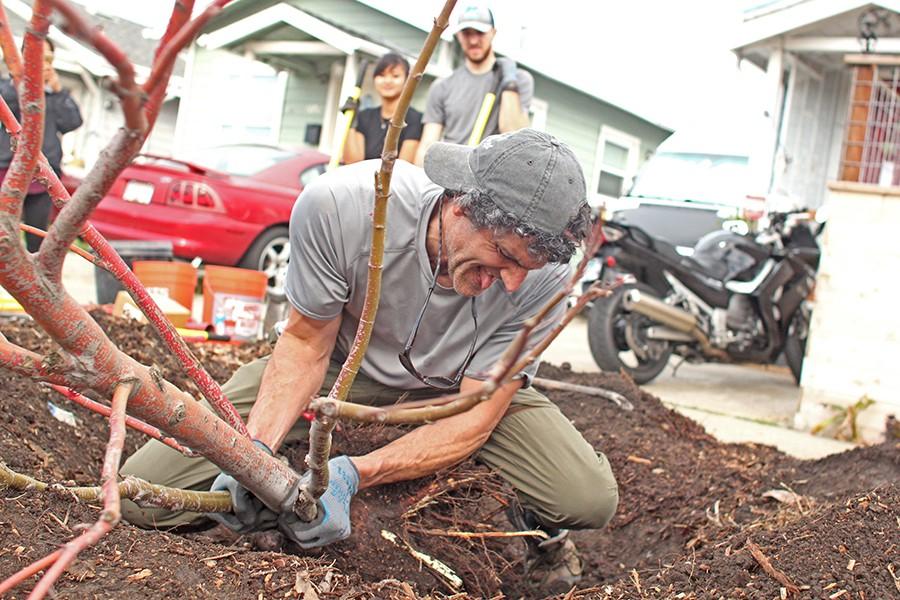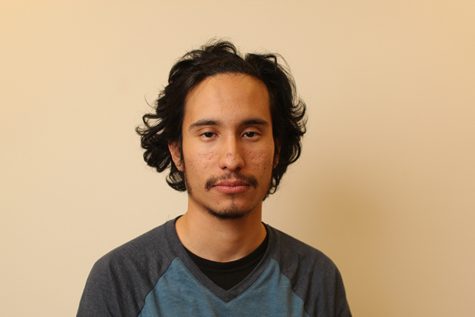Planting mitigates concrete jungle
Christian Urrutia / The Advocate
Rockridge resident Chris Randel forcibly removes a live Japanese Maple tree in the front yard of 2031 Rheem Avenue in Richmond on Feb. 14. Randel was part of a volunteer group that is overseen by the Watershed Project, a nonprofit organization bent on restoring the surrounding watersheds.
Feb 25, 2016
RICHMOND — A group of nine volunteers, including employees of the Watershed Project, came together on Rheem Avenue for a very different Valentine’s Day activity on Feb. 14.
The Watershed Project, a nonprofit organization whose mission statement “is to educate and inspire communities to protect their local watersheds,” held a tree planting volunteer event on Rheem Avenue with the goal of planting six trees up and down the street.
A watershed is defined as an area or ridge of land that separates waters flowing to different rivers, basins or seas.
This select service for residencies was made available through the Cal Fire grant, Urban and Community Forestry. It continues to sponsor the Watershed Project’s efforts.
But the small event is part of an expansive collaboration between the City of Richmond and another nonprofit, Richmond Trees, as volunteers strive for promotion and growth of the city’s urban forest and green infrastructure through community action and education.
According to the Watershed Project’s environmental educator Jennies Tran, Richmond Trees reached out to the Watershed Project in order to contribute to a shared goal of planting 10,000 trees within 10 years.
This is to counter the air pollution and improve surrounding greenery.
“Our goal is to plant 150 (within) two years for the local watershed but our vision is the 10,000 trees (initiative), which is in part because of the grant,” Tran said.
“We’re targeting under- resourced areas. We conducted research suggesting a link between affluent neighborhoods and parks leading to exercise and with lower income areas with less trees that are unkempt, there tends to be higher rates of mortality.”
Improved air quality, carbon sequestration and improving environmental health are some of the ideas behind the day’s activities.
Watershed Project education coordinator Liza Dadiomov said, “We’re very hands-on toward restoring our watershed, (tree planting) helps soften urban landscapes. We plant as many as we can. This is our third or fourth (tree planting) and anyone is welcome.”
She also said, “Everything we do is looking at the watershed as a whole and our approach is holistic, top to bottom, starting with preventing pollution going to the watershed and planting trees, rain gardens and bio swells.”
Strawberry trees were the replacements for the dead tree spots selected.
Ultimately, grants like the Urban and Community Forestry include planting larger trees like oaks and tracking greenhouse gases. Street trees are smaller therefore capturing less carbon dioxide, while oak trees contain a lot more carbon but also require large (planting) areas, Tran said.
“The tree planting (season) runs through March and our priority is the longevity of the tree and maintaining the trees through the first two years,” Tran said.
Hassan Ngadi, the Watershed Project’s greening and urban project coordinator, said the nonprofit needs to plant redwoods but that effort could not be feasible on Richmond city streets.
“We have to acknowledge the area (we live in) so we have to do it in parks. That involves canvassing, meaning we interact and talk with residents about what we are doing.
“We owe it to the next generation. Planting trees is education; we have arborists coming out and educating volunteers in order to raise expectations for ourselves and plant bigger number(s) of trees,” Ngadi said.



